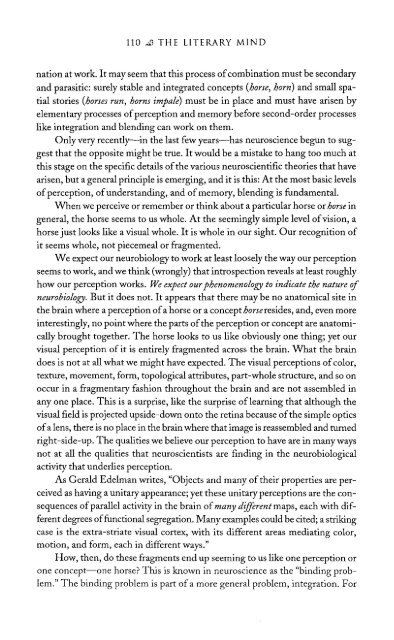The Literary Mind.pdf
The Literary Mind.pdf
The Literary Mind.pdf
You also want an ePaper? Increase the reach of your titles
YUMPU automatically turns print PDFs into web optimized ePapers that Google loves.
110 THE LITERARY MIND<br />
nation at work. It may seem that this process of combination must be secondary<br />
and parasitic: surely stable and integrated concepts (horse, horn) and small spatial<br />
stories (horses run, horns impale) must be in place and must have arisen by<br />
elementary processes of perception and memory before second-order processes<br />
like integration and blending can work on them.<br />
Only very recently—in the last few years—has neuroscience begun to suggest<br />
that the opposite might be true. It would be a mistake to hang too much at<br />
this stage on the specific details of the various neuroscientific theories that have<br />
arisen, but a general principle is emerging, and it is this: At the most basic levels<br />
of perception, of understanding, and of memory, blending is fundamental.<br />
When we perceive or remember or think about a particular horse or horse in<br />
general, the horse seems to us whole. At the seemingly simple level of vision, a<br />
horse just looks like a visual whole. It is whole in our sight. Our recognition of<br />
it seems whole, not piecemeal or fragmented.<br />
We expect our neurobiology to work at least loosely the way our perception<br />
seems to work, and we think (wrongly) that introspection reveals at least roughly<br />
how our perception works. We expect our phenomenology to indicate the nature of<br />
neurobiology. But it does not. It appears that there may be no anatomical site in<br />
the brain where a perception of a horse or a concept horse resides, and, even more<br />
interestingly, no point where the parts of the perception or concept are anatomically<br />
brought together. <strong>The</strong> horse looks to us like obviously one thing; yet our<br />
visual perception of it is entirely fragmented across the brain. What the brain<br />
does is not at all what we might have expected. <strong>The</strong> visual perceptions of color,<br />
texture, movement, form, topological attributes, part-whole structure, and so on<br />
occur in a fragmentary fashion throughout the brain and are not assembled in<br />
any one place. This is a surprise, like the surprise of learning that although the<br />
visual field is projected upside-down onto the retina because of the simple optics<br />
of a lens, there is no place in the brain where that image is reassembled and turned<br />
right-side-up. <strong>The</strong> qualities we believe our perception to have are in many ways<br />
not at all the qualities that neuroscientists are finding in the neurobiological<br />
activity that underlies perception.<br />
As Gerald Edelman writes, "Objects and many of their properties are perceived<br />
as having a unitary appearance; yet these unitary perceptions are the consequences<br />
of parallel activity in the brain of many different maps, each with different<br />
degrees of functional segregation. Many examples could be cited; a striking<br />
case is the extra-striate visual cortex, with its different areas mediating color,<br />
motion, and form, each in different ways."<br />
How, then, do these fragments end up seeming to us like one perception or<br />
one concept—one horse? This is known in neuroscience as the "binding problem."<br />
<strong>The</strong> binding problem is part of a more general problem, integration. For















